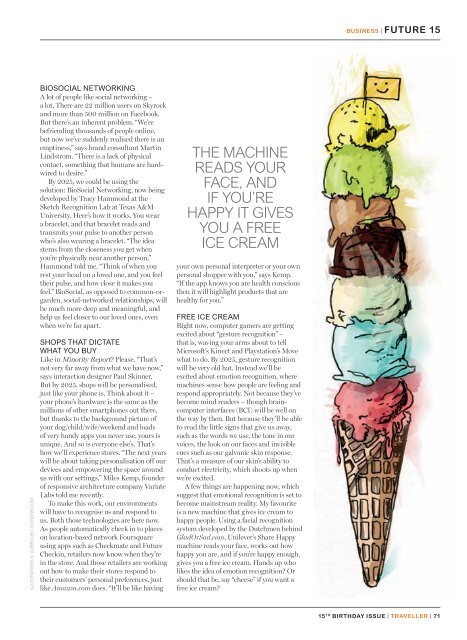november-2010
november-2010
november-2010
You also want an ePaper? Increase the reach of your titles
YUMPU automatically turns print PDFs into web optimized ePapers that Google loves.
ILLUSTRATIONS © JO BIRD/JELLYLONDON.COM<br />
BIOSOCIAL NETWORKING<br />
A lot of people like social networking –<br />
a lot. There are 22 million users on Skyrock<br />
and more than 500 million on Facebook.<br />
But there’s an inherent problem. “We’re<br />
befriending thousands of people online,<br />
but now we’ve suddenly realised there is an<br />
emptiness,” says brand consultant Martin<br />
Lindstrom. “There is a lack of physical<br />
contact, something that humans are hardwired<br />
to desire.”<br />
By 2025, we could be using the<br />
solution: BioSocial Networking, now being<br />
developed by Tracy Hammond at the<br />
Sketch Recognition Lab at Texas A&M<br />
University. Here’s how it works. You wear<br />
a bracelet, and that bracelet reads and<br />
transmits your pulse to another person<br />
who’s also wearing a bracelet. “The idea<br />
stems from the closeness you get when<br />
you’re physically near another person,”<br />
Hammond told me. “Think of when you<br />
rest your head on a loved one, and you feel<br />
their pulse, and how close it makes you<br />
feel.” BioSocial, as opposed to common-orgarden,<br />
social-networked relationships, will<br />
be much more deep and meaningful, and<br />
help us feel closer to our loved ones, even<br />
when we’re far apart.<br />
SHOPS THAT DICTATE<br />
WHAT YOU BUY<br />
Like in Minority Report? Please. “That’s<br />
not very far away from what we have now,”<br />
says interaction designer Paul Skinner.<br />
But by 2025, shops will be personalised,<br />
just like your phone is. Think about it –<br />
your phone’s hardware is the same as the<br />
millions of other smartphones out there,<br />
but thanks to the background picture of<br />
your dog/child/wife/weekend and loads<br />
of very handy apps you never use, yours is<br />
unique. And so is everyone else’s. That’s<br />
how we’ll experience stores. “The next years<br />
will be about taking personalisation off our<br />
devices and empowering the space around<br />
us with our settings,” Miles Kemp, founder<br />
of responsive architecture company Variate<br />
Labs told me recently.<br />
To make this work, our environments<br />
will have to recognise us and respond to<br />
us. Both those technologies are here now.<br />
As people automatically check in to places<br />
on location-based network Foursquare<br />
using apps such as Checkmate and Future<br />
Checkin, retailers now know when they’re<br />
in the store. And those retailers are working<br />
out how to make their stores respond to<br />
their customers’ personal preferences, just<br />
like Amazon.com does. “It’ll be like having<br />
THE MACHINE<br />
READS YOUR<br />
FACE, AND<br />
IF YOU’RE<br />
HAPPY IT GIVES<br />
YOU A FREE<br />
ICE CREAM<br />
your own personal interpreter or your own<br />
personal shopper with you,” says Kemp.<br />
“If the app knows you are health conscious<br />
then it will highlight products that are<br />
healthy for you.”<br />
FREE ICE CREAM<br />
Right now, computer gamers are getting<br />
excited about “gesture recognition” –<br />
that is, waving your arms about to tell<br />
Microsoft’s Kinect and Playstation’s Move<br />
what to do. By 2025, gesture recognition<br />
will be very old hat. Instead we’ll be<br />
excited about emotion recognition, where<br />
machines sense how people are feeling and<br />
respond appropriately. Not because they’ve<br />
become mind readers – though braincomputer<br />
interfaces (BCI) will be well on<br />
the way by then. But because they’ll be able<br />
to read the little signs that give us away,<br />
such as the words we use, the tone in our<br />
voices, the look on our faces and invisible<br />
cues such as our galvanic skin response.<br />
That’s a measure of our skin’s ability to<br />
conduct electricity, which shoots up when<br />
we’re excited.<br />
A few things are happening now, which<br />
suggest that emotional recognition is set to<br />
become mainstream reality. My favourite<br />
is a new machine that gives ice cream to<br />
happy people. Using a facial recognition<br />
system developed by the Dutchmen behind<br />
GladOrSad.com, Unilever’s Share Happy<br />
machine reads your face, works out how<br />
happy you are, and if you’re happy enough,<br />
gives you a free ice cream. Hands up who<br />
likes the idea of emotion recognition? Or<br />
should that be, say “cheese” if you want a<br />
free ice cream?<br />
BUSINESS | FUTURE 15<br />
15 TH BIRTHDAY ISSUE | TRAVELLER | 71















